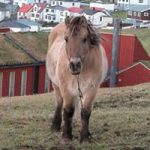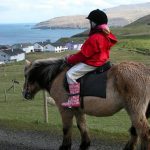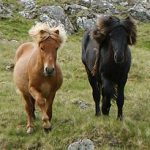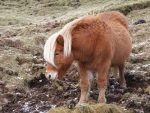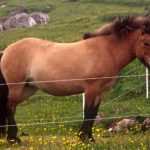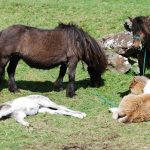Faroe Pony
The Faroe Pony is a small-statured equine breed, indigenous to the Faroe Islands. Though categorized as a pony due to its height, its immense strength makes people regard it as a horse in the Faroe Islands. Because of its hardy and amicable nature, the Faroe Pony is a suitable mount for children in the Island interested in learning horse riding.
Faroe Pony Pictures
- Faeroes Pony
- Faroe Pony Images
- Faroe Pony Pictures
- Faroe Pony Stallion
- Faroe Pony
- Faroese Horse
Quick Information
| Other Names | Faeroes Pony, Faroese horse, Faeroe Island Horse, Foroyski Hesturin ( Faroese) |
| Temperament/ Personality | Clever, sure-footed, friendly, |
| Physical Characteristics | Small size; a hardy built; long, dense, water-repellent winter coat; smooth and short haired summer coat |
| Colors | Chestnut, dun, palomino, bay, brown, speckled or black; and white |
| Common Use | Work, and riding horse |
| Height | 11.1 to 12.1 hands |
| Weight | 550 to 660 pounds |
| Lifespan | Though exact details unknown but they are said to live for a longer time |
| Health | No known breed-related health issues |
| Gaited | Have five gaits including the tolt and ambling ( just as the Icelandic horse) |
| Popular Traits | Thick-haired, adaptable, |
| Feeding/ Diet | Hay and grain |
| Country of Origin | Faroe Islands |
| Year of development | Much before the 6th century |
| Ancestors | Though not much information has been obtained about its real ancestors; it is said to have a link with the Icelandic horse, Eriskay pony, Dole horse, Fjord horse, Exmoor pony |
Faroe Pony Video
History
Though not much is known about the history of origination of the Faroe Pony, they had been mentioned of in written sources during the 1600s. These hardy horses may have evolved from the breeds brought to the island by the Celtics and Scandinavians as they migrated there. During the olden times, they were used as workhorses for the purpose of hauling heavy loads in the farm. Certain sources have even stated the ponies were trained for herding sheep. When they were not working, they were set free to roam about in the mountainous terrain of the island.
In the present times, their usage pertains to hobby breeders as well as mounts for younger ones. Dwelling in this island for more than hundred years, over 800 of these horses had been registered in the year 1880. However, their population saw a major decline in the 1960s with only 5 or 6 of them remaining. One of the main reasons for this reduction may be the increased export of these horses to the United Kingdom in between 1850 and 1920 where they were used as pit ponies in the mining industry.
Leivur T. Hansen initiated a breeding program for the purpose of conserving these horses, while an organization by the name, the Breeders of Faroe Ponies (Felagio Foroysk Ross) developed in 1970. The efforts have paid off with the numbers of these ponies rising to 70, all of which being declared as genetically pure. However, the goal is to work for the breed’s development further. Because of the lack of an adequate Border Inspection Post, they cannot be exported elsewhere, decreasing their popularity in other countries.


